I used the body of rather small squid. The stuffing is lump crab meat (not canned), minced shallot, minced fresh tarragon (from our garden) and basil. I seasoned it with salt and pepper. The proportions are sort of arbitrary as I made it. Stuff 2/3 of the squid body with the crab meat stuffing and close it with a tooth pick. I sauteed it in a frying pan with a bit of olive oil for 3 minutes on each side and added a small pat of butter and then put the frying pan in a 450F oven for 3 minutes to complete the cooking. Since there was stuffing left, I added a bit of mayonnaise and Dijon mustard and made small crab cakes as well.
Sunday, August 15, 2010
Small squid stuffed with crab meat イカのカニ肉詰め
Friday, August 13, 2010
Store bought sushi from a near-by market アメリカ市販のお寿司
This post is to remind those people privileged enough to have easy access to quality sushi and bento boxes, particularly in Japan, how good they have it. In the past 10 years or so, increasing numbers of gourmet markets in the U.S. as well as even regular supermarkets started carrying sushi. In many food courts like the one in Union station, you can find small sushi bars mainly for take-out. Some gourmet markets even have a small sushi bar in the store. Some cafeterias may even offer a box of sushi (mostly rolls). The quality of the sushi served in these places, however, often leaves much to be desired. If we like to have take-out sushi for a party, our best bet is to place a take-out order in our favorite sushi bar for pick up just before the party.
This one was bought from the near-by gourmet market. It is made on the premises, but not to order, the plastic sushi boxes are placed in the cold case. So, sometimes these sushi boxes may be sitting in the cold case for quite some time. I served the sushi on a plate with my asazuke and real wasabi to make it more presentable. I also made a tofu and nameko (small slimy Japanese mushroom) miso soup with a garnish of chopped scallion and myouga.
While the fish, luckily was fairly fresh if somewhat spongy, in general the quality of the sushi was dismal. As you can see in the picture the California roll barely held together. The rice balls were huge (in the U.S. big is better) and unless we practically choked ourselves stuffing them into our mouth in one bite they quickly fell apart while trying for a more manageable two bites. The rice was especially disappointing. It turned out to be dry and hard without much vinegar flavor. Although sushi means vinegared rice for some reason much of the sushi sold this way seems to leave it out--(saving costs? Americans won't notice?) So why did we even bother buying this stuff? It's better than nothing when you need a sushi fix for lunch. Desperate times call for desperate measures (Due to recent demands at work and other factors we did not have a chance to visit our sushi bar much this summer). At least, the miso soup was excellent (because I made it). We have to hit the sushi bar soon!!
Wednesday, August 11, 2010
Gambas al Ajillo 海老のニンニクオリーブオイル焼き
This is a quintessential tapas dish. As far as I am concerned, any good tapas dish can be a good Izakaya food. Many years ago, our Spanish friend served this to us at a small party held in his backyard. Since then, this "gambas" became our favorite and quick snack accompanying a drink. I think the way I make this dish is based on the recipe in my old tapas cook book with my slight modification (of course).
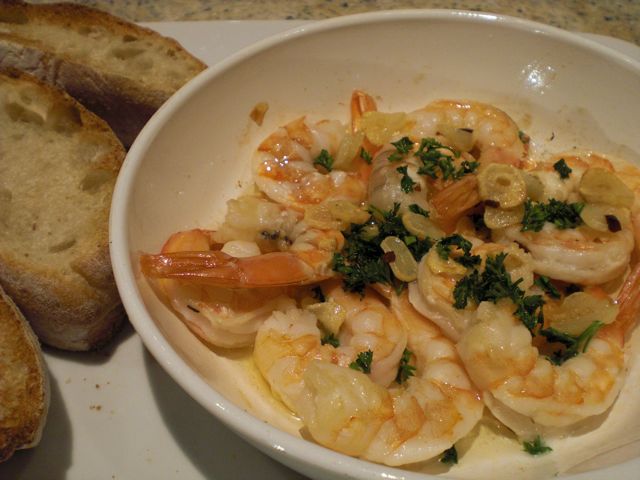
Shrimp: For this dish, relatively small shrimp (20-25 count/lb) works best. Since the vast majority of shrimp we buy here are previously frozen and thawed at the store (they say "for your convenience" but sometimes they are sitting in a case for several days after thawing), I rather buy frozen raw shrimp and thaw it myself. For quick thawing, I use running tap water. Some say the flavour will be lost in the running water but it is quick and convenient for me. Sprinkling salt on the shrimp after thawing appears to bring back some briny flavours of the ocean. This one is peeled and deveined except for the tail segment. I dry them on a paper towel.
I use a small flat Pyrex pan as seen above but any small flat pan will also work. I add 3-4 tbs of good quality olive oil (olive oil is an important part of the dish and we dip the bread to soak it all up). I thinly slice garlic (2-3 fat cloves) rather than finely mincing it. I slowly fry the garlic pieces on a low flame with red pepper flakes (whatever amount you like) until they are fragrant and the garlic slices are slightly browned. "Slowly" is important since the garlic flavour is transferred to the oil better and the garlic slices become crispy (become garlic chips) without imparting a burnt bitter taste. Take the garlic chips out of the pan and put them on a small paper towel lined plate and set aside. I then fry the shrimp in the garlic scented olive oil for 30 seconds on each side or until just done and take it off the heat. I sprinkle chopped parsley, lemon juice on the cooked shrimp and garnish with the garlic chips. You could sprinkle Spanish paprika if you wish (mostly for decoration). I do not add any salt since it was already added after the shrimp thawed.
For this, we need a rustic and crusty bread like good baguette or ciabatta. We happened to have a very nice crusty ciabatta from a local bakery. We opened the last bottle of Vilafonte. It went with the meal very well.
Shrimp: For this dish, relatively small shrimp (20-25 count/lb) works best. Since the vast majority of shrimp we buy here are previously frozen and thawed at the store (they say "for your convenience" but sometimes they are sitting in a case for several days after thawing), I rather buy frozen raw shrimp and thaw it myself. For quick thawing, I use running tap water. Some say the flavour will be lost in the running water but it is quick and convenient for me. Sprinkling salt on the shrimp after thawing appears to bring back some briny flavours of the ocean. This one is peeled and deveined except for the tail segment. I dry them on a paper towel.
I use a small flat Pyrex pan as seen above but any small flat pan will also work. I add 3-4 tbs of good quality olive oil (olive oil is an important part of the dish and we dip the bread to soak it all up). I thinly slice garlic (2-3 fat cloves) rather than finely mincing it. I slowly fry the garlic pieces on a low flame with red pepper flakes (whatever amount you like) until they are fragrant and the garlic slices are slightly browned. "Slowly" is important since the garlic flavour is transferred to the oil better and the garlic slices become crispy (become garlic chips) without imparting a burnt bitter taste. Take the garlic chips out of the pan and put them on a small paper towel lined plate and set aside. I then fry the shrimp in the garlic scented olive oil for 30 seconds on each side or until just done and take it off the heat. I sprinkle chopped parsley, lemon juice on the cooked shrimp and garnish with the garlic chips. You could sprinkle Spanish paprika if you wish (mostly for decoration). I do not add any salt since it was already added after the shrimp thawed.
For this, we need a rustic and crusty bread like good baguette or ciabatta. We happened to have a very nice crusty ciabatta from a local bakery. We opened the last bottle of Vilafonte. It went with the meal very well.
Monday, August 9, 2010
Grilled salmon with Ponzu soy sauce and Grated Daikon radish 焼塩鮭のポン酢みぞれ和え
I grated the daikon and squeeze out the excess liquid (about 1/4 cup) and added ponzu soy sauce (about 1 tbs from the bottle). I then crumbled the grilled salmon leftovers and mixed them into the daikon. I splashed Yuzu juice (from the bottle) on the top and garnished with finely julienned radish and finely sliced scallion (I used the green part for color). A simple quick dish but it was quite nice with cold sake. A good start.
Saturday, August 7, 2010
Grilled egg plant 焼き茄子
In Japan, you can get such nice and fresh vegetables, including cucumbers and eggplants, much more easily than in the U.S.. There are several kinds of Japanese eggplants; some can be even eaten raw ("water eggplant" or "Mizunasu" 水茄子). I like "Kamonasu" 賀茂茄子, famous for being used in Kyoto cuisines. You can not get these easily in the U.S.. The kind of eggplants we can get here are limited to mostly Western varieties. Occasionally, what they call a "Japanese" eggplant is available (a light purple and small elongated kind) but I do not recall seeing similar eggplants in Japan. I tend to use small Italian eggplant and Zebra eggplant for my Japanese style cooking but, sometimes, it does not work out. Simply grilled Japanese eggplant, "yakinasu" 焼き茄子 is wonderful if the eggplant is good. I found a small (baby) Italian eggplant which looked very good but bought only one, because the last time I tried to make this from Italian eggplants, it was pretty bad. I am sure, because I only got one this time, it turned out pretty good and I wish I had bought more.

Before grilling, I just prick the skin of the eggplant all over with the tines of a fork or a tip of a bamboo skewer to prevent from the eggplant from exploding (This happened once in our Weber grill. We heard a big "bong" noise. A small puff of ash came out the bottom vents of the grill. Upon investigation we found the meat of the eggplant spread all over the inside of the lid. Nothing was left on the grill except for few fragments of the charred skin.) After 15 minutes or so, the eggplant is thoroughly cooked (turn several times during the cooking) and soft as seen below. Make sure the eggplant is completely cooked. Using chopsticks or tongs, peel off the skin holding the cap while it is hot. Using a small knife or a bamboo skewer, cut the eggplant along the long axis (you can plant the skewer in the meat near the cap and then grab the cap and pull the skewer through). repeat this a few times to make long strands of eggplant. Cut at the cap but I keep the cap for presentation. I garnish with dried bonito flakes and chiffonade of perilla. As a seasoning, I can use just soy sauce but I happened to make my dipping sauce for other dishes we had (dashi 2 parts, mirin 1 part and soy sauce 2 parts) so I used my dipping sauce.
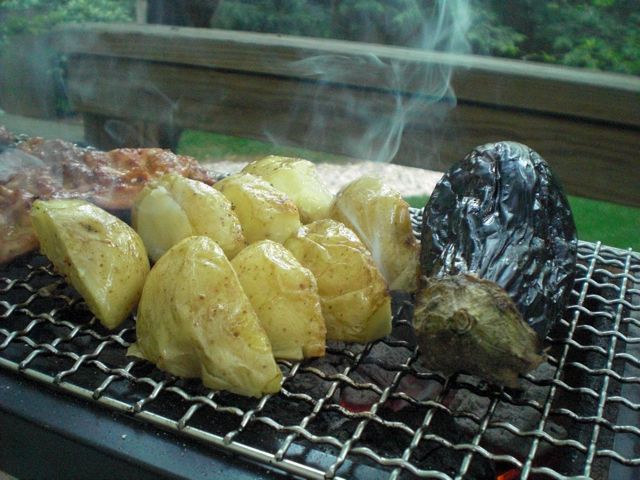
Eggplant is almost done along side potatoes which are being grilled for "Jagabata" or potato with butter.
Thursday, August 5, 2010
Grilled Trout 鱒の塩焼き
The types of fish, especially whole fish, we can get in a regular market, is very limited. Among the whole fish we can get almost all the time is a trout. I thought I bought trout that was just cleaned but it turned out this one was deboned and butterflied as well. Since we were planning to grill outside, I decided to grill this fish as planned. I sprinkled it with salt and pepper all around and put sprigs of fresh thyme and slices of lemon inside the fish.
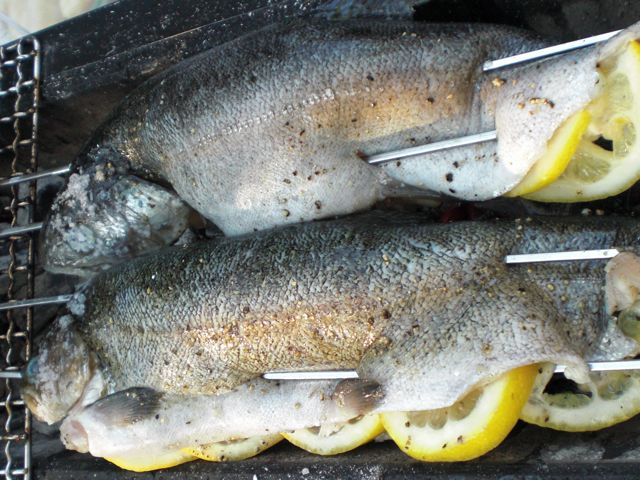
Since I do not like the skin to stick to the grill, I used two large metal skewers so that I can suspend the fish over the charcoals. The fish were fairly large but they just fit side-by-side.
 Grilled whole fish, in general, is difficult to present in a pleasing way. While trout, as a white fresh water fish can be rather bland, and if not fresh, inedible, this fish had a nice thyme flavor and the barbecue imparts a lovely smokiness. When we were in California, we used to cook trout all the time, because it was almost the only whole fish we could get, but we have not have had trout for a long time.
Grilled whole fish, in general, is difficult to present in a pleasing way. While trout, as a white fresh water fish can be rather bland, and if not fresh, inedible, this fish had a nice thyme flavor and the barbecue imparts a lovely smokiness. When we were in California, we used to cook trout all the time, because it was almost the only whole fish we could get, but we have not have had trout for a long time.
I fondly remember the large juicy grilled herring I ate at the Robatayaki/Izakaya specializing in grilled fish, which was next door to the my old favorite "Oden" place, Kastuya, before it moved from the quaint dead-end alley way near Oodouri park 大通公園 in Sapporo 札幌.
I fondly remember the large juicy grilled herring I ate at the Robatayaki/Izakaya specializing in grilled fish, which was next door to the my old favorite "Oden" place, Kastuya, before it moved from the quaint dead-end alley way near Oodouri park 大通公園 in Sapporo 札幌.
Monday, August 2, 2010
Myouga pickled in sweet vinegar 冥加の甘酢漬 Myouga asazuke 冥加の浅漬
This is probably the last installment of my "myouga" series. This year's crop was not as good as other years but we had enough myouga to enjoy.
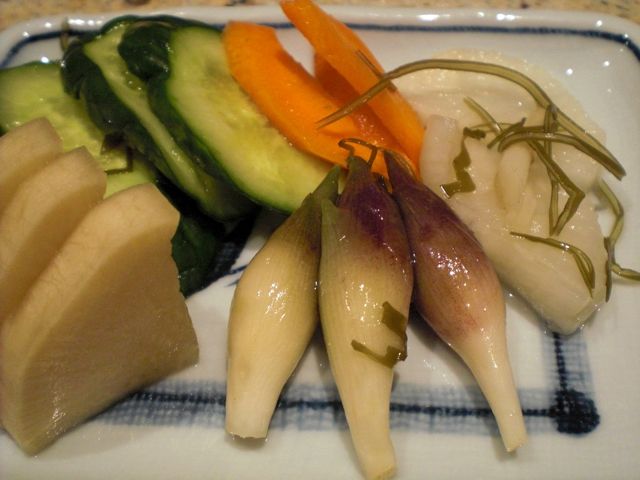
I think I am running out of myouga recipes. You could of course use finely chopped myouga as a condiment for anything including cold tofu 冷や奴, miso or clear soup, chawanmushi 茶碗蒸し, noodle dishes, sunomono 酢の物 dishes etc.
The picture below is myouga in sweet vinegar. This is a rather common preparation of myouga and I was told you could get this as a commercial product (in Japan). The recipe is rather simple. I first make sweet vinegar by dissolving sugar in Japanese rice vinegar (I used about 100m of vinegar with 4 tbs of sugar but the proportion is to your taste. I thought this was a bit too sweet but my wife thought it was just fine). I just microwaved it for 30-40 seconds or until the vinegar is warm enough to dissolve the sugar completely. Do not boil, it will make the vinegar less potent. (On the other hand, you may want to gently boil it in a pan to make the sweet vinegar more mellow). I then blanched the cleaned myouga, drained and added it to the sweet vinegar while the myouga are still hot. I keep this in a refrigerator for at least 3 days before eating. The one shown here is about a week old and still nicely crunchy with a sweet vinegar flavor mixed with the distinctive myouga taste. I do not know how long this will keep but I am sure, at least, several weeks. This is perfect for sipping sake or with rice.
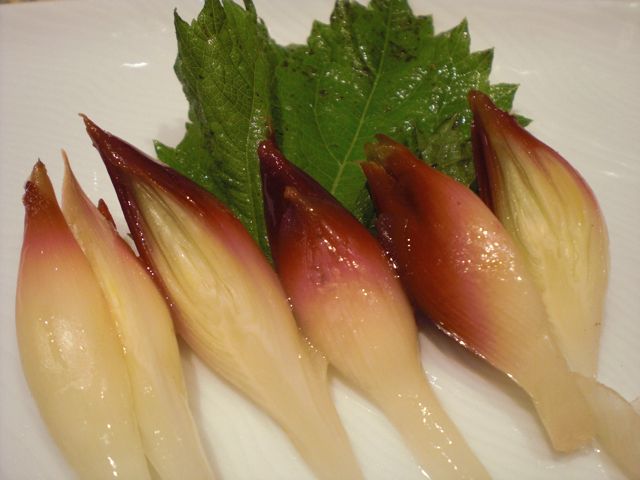 This is an assortment of asazuke 浅漬け (cucumber, carrot, daikon, in the back from left to right) and beer marinated daikon (front left) but the main item is, of course, myouga. I made the other vegetables exactly the same way as I posted before but I did not add ginger or hot pepper flakes. In addition to the nice myouga buds, I also added the chopped up stalk of myouga as well. This one has a purely myouga flavor with nice crisp texture.
This is an assortment of asazuke 浅漬け (cucumber, carrot, daikon, in the back from left to right) and beer marinated daikon (front left) but the main item is, of course, myouga. I made the other vegetables exactly the same way as I posted before but I did not add ginger or hot pepper flakes. In addition to the nice myouga buds, I also added the chopped up stalk of myouga as well. This one has a purely myouga flavor with nice crisp texture.
Subscribe to:
Posts (Atom)


